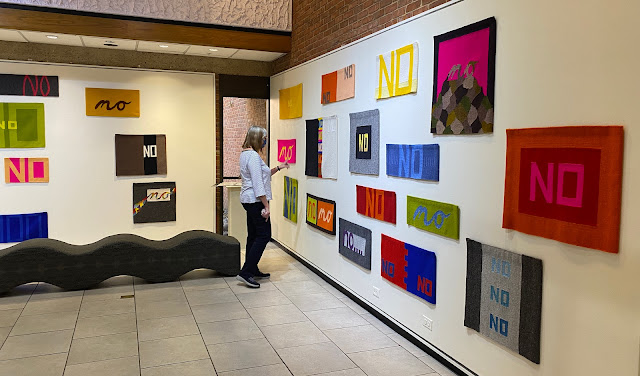 |
| Susan Iverson's Color of NO tapestries on view at Vanderbilt University's Sarratt Gallery |
One of many high points of my recent visit to Nashville, Tennessee to teach was the chance to view Susan Iverson's series of tapestries called The Color of NO on display in the Sarratt Gallery at Vanderbilt University. I had seen some of these pieces in print and online, but as we all know, there's nothing like viewing textiles in person. On the gallery website the exhibit is tagged "Hand Woven Tapestries Exploring Color Theory, Fonts and the Numerous Expressions of the Word 'No'," which neatly describes what these tapestries do. The exhibit will run through May 13, 2022, and if you can't get to Nashville, you can see Susan Iverson's work at her website.
 |
| Susan Iverson's Color of NO tapestries on view at Vanderbilt University's Sarratt Gallery |
I was surprised to find that my first reaction to seeing 30-odd tapestries all proclaiming NO was YES!! There was a brief moment of feeling taken aback, as if I were being shouted at by some unseen disciplinarian, but that quickly gave way to smiling delight at the wit and sheer inventive variety of ways that Iverson found to weave the word No. I enjoyed noticing how the colors of the word and the backgrounds interacted with each other on a formal basis and also how they affected the tone of the word.
As Iverson herself says,
While “NO” can be seen as a simple negative, the manner in which we use this word is wide and varied, from an explosive negative to a soothing denial. By repeating this short, declarative word within fairly simple compositions, the color changes become more inter-twined with the meaning and usage of the word. Loud, warm, aggressive, fertile, confrontational, humorous - these are just a few of the words that can be used to define the deepened meaning provided by the colors. It is a word that is shouted, whispered, sighed, said in fear, said in pleasure, said with firmness and said with no conviction at all.
Notice how different this NO
feels from this one:Iverson dyes her own fibers, and the innate qualities of fibers and dyed color deeply inform the series. In her own words:I really enjoyed taking in the impact of the exhibit as a whole and then stepping in closer to appreciate the weaverly attention to detail that Iverson employed.
 |
| Susan Iverson, detail |
Also fun to contemplate was the variety of shapes, sizes, and formats Iverson used. She could have rung the changes in color and font in a consistent format (say, all 8 1/2" x 11", like a page of paper), but she chose instead to vary the format and orientation of each tapestry, to underscore the variety of ways in which the word can be said and interpreted. In some tapestries the word appears once; in one as many as six times.
How does placing NO in block letters, woven in gold metallic thread, at the bottom right corner of an elongated rectangle change the way we hear it?
I found myself wondering, What word could I weave over and over, or what image, to explore as many variations as I could, and how could those variations play off of each other and also keep me interested as a weaver?
I found myself wondering if there was a connection to a Zen koan I had recently read about. It goes like this: "Someone asked Zhaozou, 'Does a dog have Buddha nature or not? Zhaozou said, 'No.'"* (Again, my first response was to be taken aback. As a dog lover I sometimes think only dogs have Buddha nature. But I digress.) As far as I can tell, koans are meant to short-circuit our ordinary supposedly rational thought processes and force a new understanding of things. I don't pretend to have had an Aha moment about this koan or its relation to Iverson's artistic intentions--in fact when I asked she said she was unaware of the koan--but the story illustrates the power of a short common word to unfold many layers of subtle meaning, or at least to reveal the limits of our conventional understanding of the word.
Iverson's series has been shown in four solo exhibits thus far and is available for future exhibits. She can be contacted through her website.
Ultimately, Iverson's series set me off on a path of rumination that has no clear, final and resolved meaning or emotion. By repeating a word in so many ways, Iverson has in a way rendered it free of meaning; it becomes a series of abstract shapes interacting. She has spoken and at the same time refused to speak, finally throwing the whole question of the meaning of No firmly back to the viewer, where it reverberates.
* The book where I found this is entitled Bring Me the Rhinoceros: and other Zen Koans that Will Save your Life by John Tarrant. I really enjoyed it.



